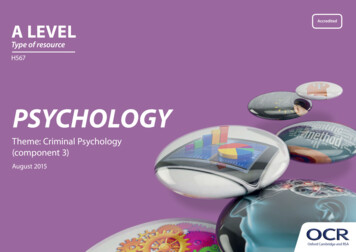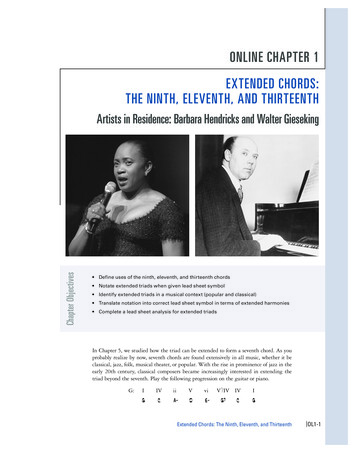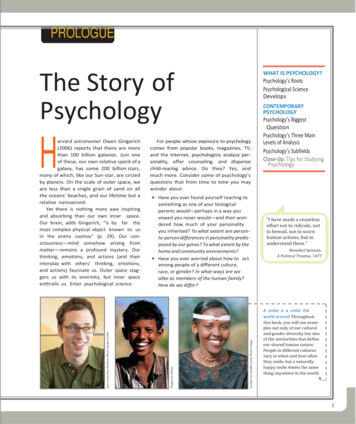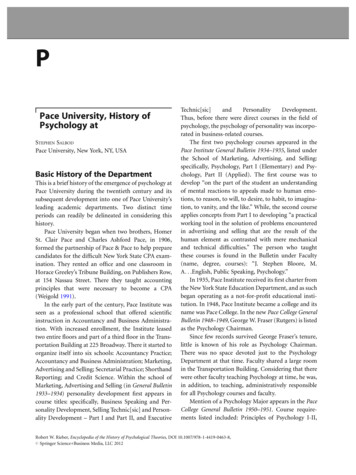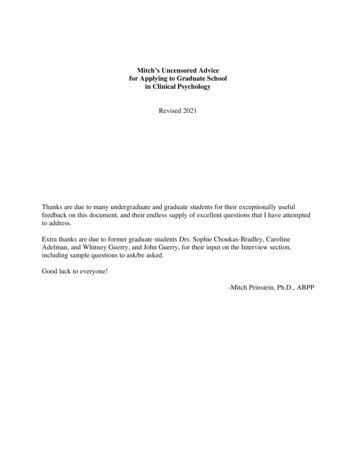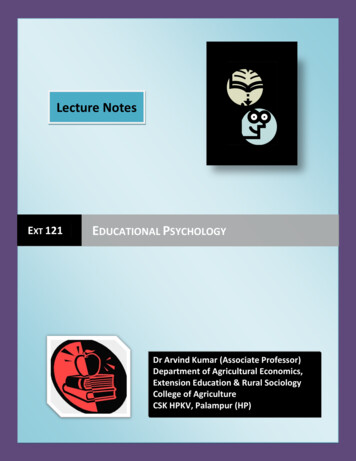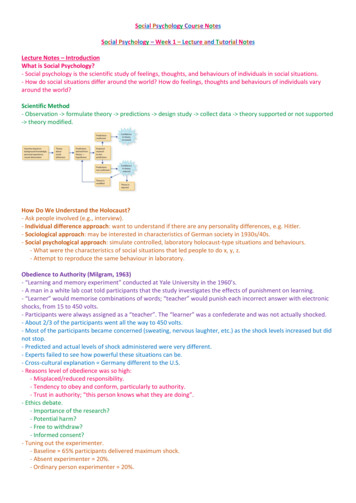
Transcription
Learningmodules23When a chinook salmon first emerges from its egg in a stream’s gravel bed, itsgenes provide most of the behavioral instructions it needs for life. It knowsinstinctively how and where to swim, what to eat, and how to protect itself.Following a built-in plan, the young salmon soon begins its trek to the sea.After some four years in the ocean, the mature salmon returns to its birthplace. Itnavigates hundreds of miles to the mouth of its home river and then, guided by thescent of its home stream, begins an upstream odyssey to its ancestral spawningground. Once there, the salmon seeks out the best temperature, gravel, and waterflow for breeding. It then mates and, its life mission accomplished, dies.Unlike salmon, we are not born with a genetic plan for life. Much of what we dowe learn from experience. Although we struggle to find the life direction a salmon isborn with, our learning gives us more flexibility. We can learn how to build grass hutsor snow shelters, submarines or space stations, and thereby adjust to almost any environment. Indeed, nature’s most important gift to us may be our adaptability—ourcapacity to learn new behaviors that help us cope with changing circumstances.Learning breeds hope. What is learnable we can potentially teach—a fact that encourages parents, educators, coaches, and animal trainers. What has been learned wecan potentially change by new learning—an assumption that underlies counseling,psychotherapy, and rehabilitation programs. No matter how unhappy, unsuccessful,or unloving we are, that need not be the end of our story.No topic is closer to the heart of psychology than learning, a relatively permanentbehavior change due to experience. Psychologists study the learning of visual perceptions, of a drug’s expected effect, of gender roles. They also consider how learningshapes our thought and language, our motivations and emotions, our personalitiesand attitudes. Modules 23 through 25 examine three types of learning: classicalconditioning, operant conditioning, and observational learning.Classical Conditioning24Operant Conditioning25Learning by Observation“Learning is the eye of the mind.”Thomas Drake, Bibliotheca ScholasticaInstructissima, 1633䉴 How Do We Learn?More than 200 years ago, philosophers such as John Locke and David Hume echoedAristotle’s conclusion from 2000 years earlier: We learn by association. Our mindsnaturally connect events that occur in sequence. Suppose you see and smell freshlybaked bread, eat some, and find it satisfying. The next time you see and smell freshbread, that experience will lead you to expect that eating it will once again be satisfying. So, too, with sounds. If you associate a sound with a frightening consequence,hearing the sound alone may trigger your fear. As one 4-year-old exclaimed afterwatching a TV character get mugged, “If I had heard that music, I wouldn’t have gonearound the corner!” (Wells, 1981).Learned associations also feed our habitual behaviors (Wood & Neal, 2007). As werepeat behaviors in a given context—the sleeping posture we associate with bed, ourwalking routes on campus, our eating popcorn in a movie theater—the behaviors become associated with the contexts. Our next experience of the context then automatically triggers the habitual response. Such associations can make it hard to kick a 1984 by Sidney Harris, American Scientist Magazine.23-1 What are some basic forms of learning?“Actually, sex just isn’t that important to me.”287
䉳Jouanneau Thomas/CORBIS SYGMA288Nature without appropriate nurtureKeiko—the killer whale of Free Willyfame—had all the right genes for beingdropped right back into his Icelandichome waters. But lacking life experience,he required caregivers to his life’s end ina Norwegian fjord. Most of us would be unable to namethe order of the songs on our favoriteCD or playlist. Yet, hearing the end ofone piece cues (by association) ananticipation of the next. Likewise, whensinging your national anthem, youassociate the end of each line with thebeginning of the next. (Pick a line outof the middle and notice how muchharder it is to recall the previous line.) smoking habit; when back in the smoking context, the urge to light up can be powerful (Siegel, 2005).Other animals also learn by association. Disturbed by a squirt of water, the seaslug Aplysia protectively withdraws its gill. If the squirts continue, as happens naturally in choppy water, the withdrawal response diminishes. (The slug’s response habituates.) But if the sea slug repeatedly receives an electric shock just after beingsquirted, its withdrawal response to the squirt instead grows stronger. The animal relates the squirt to the impending shock. Complex animals can learn to relate theirown behavior to its outcomes. Seals in an aquarium will repeat behaviors, such asslapping and barking, that prompt people to toss them a herring.By linking two events that occur close together, both the sea slug and the seals exhibit associative learning. The sea slug associates the squirt with an impending shock;the seal associates slapping and barking with a herring treat. Each animal has learnedsomething important to its survival: predicting the immediate future.The significance of an animal’s learning is illustrated by the challenges captivebred animals face when introduced to the wild. After being bred and raised in captivity, 11 Mexican gray wolves—extinct in the United States since 1977—were released inArizona’s Apache National Forest in 1998. Eight months later, a lone survivor was recaptured. The pen-reared wolves had learned how to hunt—and to move 100 feetaway from people—but had not learned to run from a human with a gun. Their storyis not unusual. Twentieth-century records document 145 reintroductions of 115species. Of those, only 11 percent produced self-sustaining populations in the wild.Successful adaptation requires both nature (the needed genetic predispositions) andnurture (a history of appropriate learning).Conditioning is the process of learning associations. In classical conditioning, thetopic of Module 23, we learn to associate two stimuli and thus to anticipate events.We learn that a flash of lightning signals an impending crack of thunder, so whenlightning flashes nearby, we start to brace ourselves (FIGURE 1).In operant conditioning, Module 24’s focus, we learn to associate a response (our behavior) and its consequence and thus to repeat acts followed by good results (FIGURE 2)and avoid acts followed by bad results.To simplify, we will explore these two types of associative learning separately inModules 23 and 24. Often, though, they occur together, as on one Japanese cattleranch, where the clever rancher outfitted his herd with electronic pagers, which heTwo related events:Stimulus 1:LightningStimulus 2:ThunderResult after repetition:Stimulus:We seelightning䉴FIGURE 1 Classical conditioningResponse:We wince,anticipatingthunder
289(b) Consequence: receiving food(c) Behavior strengthened䉳(a) Response: balancing a ballFIGURE 2 Operant conditioningcalls from his cellphone. After a week of training, the animals learn to associate twostimuli—the beep on their pager and the arrival of food (classical conditioning). Butthey also learn to associate their hustling to the food trough with the pleasure of eating (operant conditioning).The concept of association by conditioning provokes questions: What principlesinfluence the learning and the loss of associations? How can these principles be applied? And what really are the associations: Does the beep on a steer’s pager evoke amental representation of food, to which the steer responds by coming to the trough?Or does it make little sense to explain conditioned associations in terms of cognition?These questions are among the many being studied by researchers exploring how thebrain stores and retrieves learning.Conditioning is not the only form of learning. As Module 25 explains, we alsolearn from others’ experiences through observational learning. Chimpanzees, too, maylearn behaviors merely by watching others perform them. If one sees another solve apuzzle and gain a food reward, the observer may perform the trick more quickly.By conditioning and by observation we humans learn and adapt to our environments. We learn to expect and prepare for significant events such as food or pain(classical conditioning). We also learn to repeat acts that bring good results and toavoid acts that bring bad results (operant conditioning). By watching others we learnnew behaviors (observational learning). And through language, we also learn thingswe have neither experienced nor observed.
Pavlov’s ExperimentsExtending Pavlov’sUnderstandingPavlov’s Legacymodule 23Classical Conditioning23-2 What is classical conditioning, and how did Pavlov’s work influencebehaviorism?associative learning learning thatcertain events occur together. The eventsmay be two stimuli (as in classical conditioning) or a response and its consequences (as in operant conditioning).classical conditioning a type oflearning in which one learns to link twoor more stimuli and anticipate events.learning a relatively permanent changein an organism’s behavior due to experience.behaviorism the view that psychology(1) should be an objective science that (2)studies behavior without reference to mental processes. Most research psychologiststoday agree with (1) but not with (2).Although associative learning had long generated philosophical discussion, only inthe early twentieth century did psychology’s most famous research verify it. For manypeople, the name Ivan Pavlov (1849–1936) rings a bell. His experiments are classics,and the phenomenon he explored we justly call classical conditioning.Pavlov’s work also laid the foundation for many of psychologist John B. Watson’sideas. In searching for laws underlying learning, Watson (1913) urged his colleaguesto discard reference to inner thoughts, feelings, and motives. The science of psychology should instead study how organisms respond to stimuli in their environments,said Watson: “Its theoretical goal is the prediction and control of behavior. Introspection forms no essential part of its methods.” Simply said, psychology should be an objective science based on observable behavior. This view, which influenced NorthAmerican psychology during the first half of the twentieth century, Watson calledbehaviorism. Watson and Pavlov shared both a disdain for “mentalistic” concepts(such as consciousness) and a belief that the basic laws of learning were the same forall animals—whether dogs or humans. Few researchers today propose that psychologyshould ignore mental processes, but most now agree that classical conditioning is abasic form of learning by which all organisms adapt to their environment.䉴 Pavlov’s Experiments23-3 How does a neutral stimulus become a conditioned stimulus?Sovfoto䉴Ivan Pavlov “Experimental investigation. . . should lay a solid foundation for afuture true science of psychology” (1927).290Pavlov was driven by a lifelong passion for research. After setting aside his initial planto follow his father into the Russian Orthodox priesthood, Pavlov received a medicaldegree at age 33 and spent the next two decades studying the digestive system. Thiswork earned him Russia’s first Nobel prize in 1904. But it was his novel experimentson learning, to which he devoted the last three decades of his life, that earned thisfeisty scientist his place in history.Pavlov’s new direction came when his creative mind seized on an incidental observation. Without fail, putting food in a dog’s mouth caused the animal to salivate.Moreover, the dog began salivating not only to the taste of the food, but also to themere sight of the food, or the food dish, or the person delivering the food, or even thesound of that person’s approaching footsteps. At first, Pavlov considered these “psychic secretions” an annoyance—until he realized they pointed to a simple but important form of learning.Pavlov and his assistants tried to imagine what the dog was thinking and feeling asit drooled in anticipation of the food. This only led them into fruitless debates. So, toexplore the phenomenon more objectively, they experimented. To eliminate otherpossible influences, they isolated the dog in a small room, secured it in a harness, andattached a device to divert its saliva to a measuring instrument. From the next room,they presented food—first by sliding in a food bowl, later by blowing meat powderinto the dog’s mouth at a precise moment. They then paired various neutral events—something the dog could see or hear but didn’t associate with food—with food in thedog’s mouth. If a sight or sound regularly signaled the arrival of food, would the doglearn the link? If so, would it begin salivating in anticipation of the food?
291Classical Conditioning M O D U L E 2 3BEFORE CONDITIONINGUS (foodin mouth)UR(salivation)An unconditioned stimulus (US) produces an unconditioned response (UR).Neutral stimulus(tone)A neutral stimulus produces no salivation response.DURING CONDITIONINGNeutralstimulus(tone) NosalivationAFTER CONDITIONINGUS (foodin mouth)UR(salivation)CR(salivation)The neutral stimulus alone now produces a conditioned response(CR), thereby becoming a conditioned stimulus (CS).䉳The unconditioned stimulus is repeatedly presented just after the neutral stimulus.The unconditioned stimulus continues to produce an unconditioned response.CS(tone)The answers proved to be yes and yes. Just before placing food in the dog’s mouth toproduce salivation, Pavlov sounded a tone. After several pairings of tone and food, thedog, anticipating the meat powder, began salivating to the tone alone. In later experiments, a buzzer, a light, a touch on the leg, even the sight of a circle set off the drooling.1 (This procedure works with people, too. When hungry young Londoners viewedabstract figures before smelling peanut butter or vanilla, their brains soon were responding in anticipation to the abstract images alone [Gottfried et al., 2003]).Because salivation in response to food in the mouth was unlearned, Pavlov calledit an unconditioned response (UR). Food in the mouth automatically, unconditionally, triggers a dog’s salivary reflex (FIGURE 23.1). Thus, Pavlov called the food stimulusan unconditioned stimulus (US).Salivation in response to the tone was conditional upon the dog’s learning the association between the tone and the food. Today we call this learned response theconditioned response (CR). The previously neutral (in this context) tone stimulusthat now triggered the conditional salivation we call the conditioned stimulus(CS). Distinguishing these two kinds of stimuli and responses is easy: Conditioned learned; unconditioned unlearned.PEANUTS reprinted by permission of UnitedFeature Syndicate, Inc.PEANUTS1TheFIGURE 23.1 Pavlov’s classicexperiment Pavlov presented a neutralstimulus (a tone) just before an unconditioned stimulus (food in mouth). Theneutral stimulus then became aconditioned stimulus, producing aconditioned response.unconditioned response (UR) inclassical conditioning, the unlearned,naturally occurring response to theunconditioned stimulus (US), such assalivation when food is in the mouth.unconditioned stimulus (US) in classical conditioning, a stimulus thatunconditionally—naturally and automatically—triggers a response.conditioned response (CR) in classical conditioning, the learned response toa previously neutral (but now conditioned) stimulus (CS).conditioned stimulus (CS) in classical conditioning, an originally irrelevantstimulus that, after association with anunconditioned stimulus (US), comes totrigger a conditioned response.“buzzer” (English translation) was perhaps Pavlov’s supposed bell—a small electric bell (Tully, 2003).
292MOD U LE 2 3 Classical ConditioningLet’s check your understanding with a second example. An experimenter sounds atone just before delivering an air puff to your blinking eye. After several repetitions,you blink to the tone alone. What is the US? The UR? The CS? The CR?2If Pavlov’s demonstration of associative learning was so simple, what did he do forthe next three decades? What discoveries did his research factory publish in his 532papers on salivary conditioning (Windholz, 1997)? He and his associates exploredfive major conditioning processes: acquisition, extinction, spontaneous recovery, generalization, and discrimination.Acquisition23-4 In classical conditioning, what are the processes of acquisition, extinction,spontaneous recovery, generalization, and discrimination? Check yourself: If the aroma of cakebaking sets your mouth to watering,what is the US? The CS? The CR?(Answers below.)Remember:US Unconditioned StimulusUR Unconditioned ResponseCS Conditioned StimulusCR Conditioned Response The cake (and its taste) are the US.The associated aroma is the CS.Salivation to the aroma is the CR.acquisition in classical conditioning,the initial stage, when one links a neutralstimulus and an unconditioned stimulusso that the neutral stimulus begins triggering the conditioned response. In operant conditioning, the strengthening of areinforced response.higher-order conditioning a procedure in which the conditioned stimulusin one conditioning experience is pairedwith a new neutral stimulus, creating asecond (often weaker) conditioned stimulus. For example, an animal that haslearned that a tone predicts food mightthen learn that a light predicts the toneand begin responding to the light alone.(Also called second-order conditioning.)To understand the acquisition, or initial learning, of the stimulus-response relationship, Pavlov and his associates had to confront the question of timing: How muchtime should elapse between presenting the neutral stimulus (the tone, the light, thetouch) and the unconditioned stimulus? In most cases, not much—half a secondusually works well.What do you suppose would happen if the food (US) appeared before the tone(CS) rather than after? Would conditioning occur?Not likely. With but a few exceptions, conditioning doesn’t happen when the CS follows the US. Remember, classical conditioning is biologically adaptive because it helpshumans and other animals prepare for good or bad events. To Pavlov’s dogs, the tone(CS) signaled an important biological event—the arrival of food (US). To deer in theforest, the snapping of a twig (CS) may signal a predator’s approach (US). If the goodor bad event had already occurred, the CS would not likely signal anything significant.Michael Domjan (1992, 1994, 2005) showed how a CS can signal another important biological event, by conditioning the sexual arousal of male Japanese quail. Justbefore presenting an approachable female, the researchers turned on a red light. Overtime, as the red light continued to herald the female’s arrival, the light caused themale quail to become excited. They developed a preference for their cage’s red-lightdistrict, and when a female appeared, they mated with her more quickly and releasedmore semen and sperm (Matthews et al., 2007). All in all, the quail’s capacity forclassical conditioning gives it a reproductive edge. Again we see the larger lesson: Conditioning helps an animal survive and reproduce—by responding to cues that help it gainfood, avoid dangers, locate mates, and produce offspring (Hollis, 1997).In humans, too, objects, smells, and sights associated with sexual pleasure—even ageometric figure in one experiment—can become conditioned stimuli for sexualarousal (Byrne, 1982). Psychologist Michael Tirrell (1990) recalls: “My first girlfriend loved onions, so I came to associate onion breath with kissing. Before long,onion breath sent tingles up and down my spine. Oh what a feeling!”(FIGURE 23.2)Through higher-order conditioning, a new neutral stimulus can become a newconditioned stimulus. All that’s required is for it to become associated with a previously conditioned stimulus. If a tone regularly signals food and produces salivation,then a light that becomes associated with the tone may also begin to trigger salivation. Although this higher-order conditioning (also called second-order conditioning)tends to be weaker than first-stage conditioning, it influences our everyday lives.Imagine that something makes us very afraid (perhaps a pit bull dog associated with aprevious dog bite). If something else, such as the sound of a barking dog, brings tomind that pit bull, the bark alone may make us feel a little afraid.2US air puff; UR blink to air puff; CS tone after procedure; CR blink to tone
293Classical Conditioning M O D U L E 2 )sexual arousal. But when repeatedlypaired with a passionate kiss, it canbecome a CS and do just that.CR(sexualarousal)Associations can influence attitudes (De Houwer et al., 2001; Park et al., 2007).As Andy Field (2006) showed British children novel cartoon characters alongsideeither ice cream (Yum!) or Brussels sprouts (Yuk!), the children came to like bestthe ice-cream–associated characters. Michael Olson and Russell Fazio (2001) classically conditioned adults’ attitudes, using little-known Pokémon characters. Theparticipants, playing the role of a security guard monitoring a video screen, vieweda stream of words, images, and Pokémon characters. Their task, they were told, wasto respond to one target Pokémon character by pressing a button. Unnoticed by theparticipants, when two other Pokémon characters appeared on the screen, one wasconsistently associated with various positive words and images (such as awesome ora hot fudge sundae); the other appeared with negative words and images (such asawful or a cockroach). Without any conscious memory for the pairings, the participants formed more gut-level positive attitudes for the characters associated withthe positive stimuli.Follow-up studies indicate that conditioned likes and dislikes are even strongerwhen people notice and are aware of the associations they have learned (De Houweret al., 2005a,b; Pleyers et al., 2007). Cognition matters.Extinction and Spontaneous RecoveryAfter conditioning, what happens if the CS occurs repeatedly without the US? Willthe CS continue to elicit the CR? Pavlov discovered that when he sounded the toneagain and again without presenting food, thedogs salivated less and less. Their decliningStrongsalivation illustrates extinction, the diminAcquisitionished responding that occurs when the CS(CS US)(tone) no longer signals an impending US(food).StrengthPavlov found, however, that if he allowedof CRseveral hours to elapse before sounding thetone again, the salivation to the tone wouldreappear spontaneously (FIGURE 23.3). Thisspontaneous recovery—the reappearance ofWeaka (weakened) CR after a pause—suggested toPavlov that extinction was suppressing the CRTimerather than eliminating it.extinction the diminishing of a conditioned response; occurs in classical conditioning when an unconditioned stimulus(US) does not follow a conditioned stimulus (CS); occurs in operant conditioningwhen a response is no longer reinforced.spontaneous recovery the reappearance, after a pause, of an extinguishedconditioned response.FIGURE 23.3 Idealized curve ofacquisition, extinction, andspontaneous recovery The rising curveshows that the CR rapidly grows strongeras the CS and US are repeatedly paired(acquisition), then weakens as the CS ispresented alone (extinction). After a pause,the CR reappears (spontaneous RE 23.2 An unexpected CS䉴 Onionbreath does not usually produceUR(sexualarousal)Extinction(CS alone)Spontaneousrecovery of CRExtinction(CS alone)Pause
294MOD U LE 2 3 Classical ConditioningAfter breaking up with his fire-breathing heartthrob, Tirrell also experienced extinction and spontaneous recovery. He recalls that “the smell of onion breath (CS),no longer paired with the kissing (US), lost its ability to shiver my timbers. Occasionally, though, after not sensing the aroma for a long while, smelling onion breathawakens a small version of the emotional response I once felt.” The New Yorker Collection, 1998, Sam Grossfrom cartoonbank.com. All rights reserved.Stimulus generalizationGeneralizationPavlov and his students noticed that a dog conditioned to the sound of one tone alsoresponded somewhat to the sound of a different tone that had never been paired withfood. Likewise, a dog conditioned to salivate when rubbed would also drool a bit whenscratched (Windholz, 1989) or when touched on a different body part (FIGURE 23.4).This tendency to respond to stimuli similar to the CS is called generalization.FIGURE 23.4 GeneralizationPavlov demonstratedgeneralization by attachingminiature vibrators to variousparts of a dog’s body. Afterconditioning salivation tostimulation of the thigh, hestimulated other areas. Thecloser a stimulated spot was tothe dog’s thigh, the stronger theconditioned response. (FromPavlov, 1927.)䉴“I don’t care if she’s a tape dispenser. I love her.”Strongest responsesfrom areas nearestthe thighDrops of saliva6050403020100HindpawPelvisThighFIGURE 23.5 Child abuse leaves UW–Madison News & Public Affairs. Photo by Jeff Miller䉴tracks in the brain Seth Pollak(University of Wisconsin–Madison)reports that abused children’ssensitized brains react more stronglyto angry faces. This generalizedanxiety response may help explainwhy child abuse puts children atgreater risk of psychological disorder.ShoulderTrunkFrontpawForelegPart of body stimulatedGeneralization can be adaptive, as when toddlers taught to fear moving cars alsobecome afraid of moving trucks and motorcycles. So automatic is generalization thatone Argentine writer who underwent torture still recoils with fear when he sees blackshoes—his first glimpse of his torturers as they approached his cell. Generalization ofanxiety reactions has been demonstrated in laboratory studies comparing abusedwith nonabused children (FIGURE 23.5). Shown an angry face on acomputer screen, abused children’s brain-wave responses are dramatically stronger and longer lasting (Pollak et al., 1998).Because of generalization, stimuli similar to naturally disgustingor appealing objects will, by association, evoke some disgust or liking. Normally desirable foods, such as fudge, are unappealingwhen shaped to resemble dog feces (Rozin et al., 1986). Adultswith childlike facial features (round face, large forehead, smallchin, large eyes) are perceived as having childlike warmth, submissiveness, and naiveté (Berry & McArthur, 1986). In both cases,people’s emotional reactions to one stimulus generalize to similarstimuli.
295Classical Conditioning M O D U L E 2 3DiscriminationPavlov’s dogs also learned to respond to the sound of a particular tone and not toother tones. Discrimination is the learned ability to distinguish between a conditioned stimulus (which predicts the US) and other irrelevant stimuli. Being able torecognize differences is adaptive. Slightly different stimuli can be followed by vastlydifferent consequences. Confronted by a pit bull, your heart may race; confronted bya golden retriever, it probably will not.generalization the tendency, once aresponse has been conditioned, for stimuli similar to the conditioned stimulus toelicit similar responses.discrimination in classical conditioning, the learned ability to distinguishbetween a conditioned stimulus andstimuli that do not signal an unconditioned stimulus.䉴 Extending Pavlov’s Understanding23-5 Do cognitive processes and biological constraints affect classicalconditioning?In their dismissal of “mentalistic” concepts such as consciousness, Pavlov and Watson underestimated the importance of cognitive processes (thoughts, perceptions, expectations) and biological constraints on an organism’s learning capacity.Cognitive ProcessesThe early behaviorists believed that rats’ and dogs’ learned behaviors could be reducedto mindless mechanisms, so there was no need to consider cognition. But RobertRescorla and Allan Wagner (1972) showed that an animal can learn the predictabilityof an event. If a shock always is preceded by a tone, and then may also be preceded bya light that accompanies the tone, a rat will react with fear to the tone but not to thelight. Although the light is always followed by the shock, it adds no new information;the tone is a better predictor. The more predictable the association, the stronger theconditioned response. It’s as if the animal learns an expectancy, an awareness of howlikely it is that the US will occur.Such experiments help explain why classical conditioning treatments that ignorecognition often have limited success. For example, people receiving therapy for alcohol dependency may be given alcohol spiked with a nauseating drug. Will they thenassociate alcohol with sickness? If classical conditioning were merely a matter of“stamping in” stimulus associations, we might hope so, and to some extent this doesoccur. However, the awareness that the nausea is induced by the drug, not the alcohol, often weakens the association between drinking alcohol and feeling sick. So,even in classical conditioning, it is (especially with humans) not simply the CS–USassociation but also the thought that counts.Biological PredispositionsEver since Charles Darwin, scientists have assumed that all animals share a commonevolutionary history and thus commonalities in their makeup and functioning. Pavlovand Watson, for example, believed the basic laws of learning were essentially similar inall animals. So it should make little difference whether one studied pigeons or people.Moreover, it seemed that any natural response could be conditioned to any neutralstimulus. As learning researcher Gregory Kimble proclaimed in 1956, “Just about anyactivity of which the organism is capable can be conditioned and . . . these responsescan be conditioned to any stimulus that the organism can perceive”
American psychology during the first half of the twentieth century, Watson called behaviorism. Watson and Pavlov shared both a disdain for “mentalistic” concepts (such as consciousness) and a belief that the basic laws of learning were the same for all animals—whether dogs or humans. Few r


